Chinese Recipes for Cooking Chinese Food, All Free Recipes
Chinese recipes are filled with wonderful flavors that bring back many happy childhood memories for me. The following are all of my favorite free recipes from China.
| Chicken Recipes | Beef Recipes | Seafood Recipes | Vegetarian Recipes | Dessert Recipes |
 China. It is a land steeped in ancient history and a culture fill with wonders and excitement. The traditional
meal time in China is usually surrounded by family members where meals are prepared in a variety of dishes
accompanied by rice or noodles. Each dish has a special meaning. For example, during special occassions such
as birthdays or weddings, noodles represent 'long life', bamboo shoots to mean 'wealth', eggs for 'fertility',
even fruits such as lychees to mean 'close family ties' and tangerines for 'good luck'. Every dish is colorful
and flavorful which is why I love Chinese food so much.
China. It is a land steeped in ancient history and a culture fill with wonders and excitement. The traditional
meal time in China is usually surrounded by family members where meals are prepared in a variety of dishes
accompanied by rice or noodles. Each dish has a special meaning. For example, during special occassions such
as birthdays or weddings, noodles represent 'long life', bamboo shoots to mean 'wealth', eggs for 'fertility',
even fruits such as lychees to mean 'close family ties' and tangerines for 'good luck'. Every dish is colorful
and flavorful which is why I love Chinese food so much.Chinese cooking is one of the easiest cooking to attempt and has become increasingly popular in the West for the last three decades. It has seen a gradual progression from the hot kitchens of Chinese restaurants to home kitchnes. So long as you have all the main ingredients ready to go, you will have no problems making them. Speedy stir-fry ensures that you will have the most delicious, aromatic and exotic dish within minutes. The best part of Chinese cooking is because the food is cooked rapidly, it maintains much of its vitamins, color and texture. Make sure you have everything ready for a stir-fry as it it takes literally minutes to complete a whole dish.
Chinese cooking makes an abundant use of vegetables. By stir-frying fresh vegetables, you can preserve their crunchiness (texture), the wonderful vivid color, the robust flavor and even maintain the vitamin cotent. It may take a little getting used to as the names might throw you off but don't let that stop you from trying delicious vegetables like Gai Lan or Buck Choi with your meals. Experiment with other root vegetables like lotus and taro roots instead of plain potatoes.
There are also dishes that you can make with noodles such as the ever popular Shanghai Noodles and Wonton Noodles which is wonderful in the winter months. Or simply choose to start with the basic by stir-frying a very simple dish known as Fried Egg Noodles Chinese style Egg Fried Rice is a good way to use left-over rice and is quite filling as a main dish by itself. I hope that you would try as many of the Chinese recipes below. Remember, as always, these are merely guidelines so experiment and adjust to your palate.
The Chinese wok is considered a necessary and essential tool in any Chinese cooking. It is perhaps the perfect invention since the wheel. It's round-based pan is designed to cook any sliced (fine) and chopped ingredients quickly, evenly and rapidly. You only have to keep the food moving throughout the process, making sure you don't burn the ingredients. It may take time but it will only come with practise. Not only is the wok a perfect balance for stir-frying, it is also multi-functional as it can be used to steam, poach, deep-fry and even bake. However, if you cannot gain access to a wok, use a good non-stick pan instead. For more information with regards to cooking with Chinese utensils, click here.
The Low-Down on Salt in Chinese Cooking I'm reminded of my recent conversation with my sister on the issue of too much salt in Chinese cooking. While it is true that Chinese cooking uses a lot of salt (e.g. soy sauce) in the dishes, you can actually cut down on the amount of salt in the cooking by simply using stocks (chicken/beef/pork etc) for flavor. You can futher cut down on the sodium content by choosing to make your own homemade stock instead of buying canned ones or bouillion cubes. Increase the flavor of your dish by spicing it and increasing the amount of ginger, garlic etc.
Chinese desserts in my opinion are usually light and refreshing. They are often not too sweet, sometimes a little salty or a combination of sweet and salty. If you haven't already tried Bubble Tea, you should really give it a go. It isn't exactly tea per se but a delightful fruity drink, usually taro, mango or whatever you desire with round black tapioca balls. This drink can be served hot or cold. Other Chinese desserts include Almond Curd Junket, Deep Fried Wonton with Ice Cream, (a very clever way to use left-over wontons) and my absolute favorite to make Deep Fried Ice Cream with Coconut. Even if you do not have the time to prepare these wonderful recipes, you can always serve a platter with exotic fruits such as lychees, papaya, rambutans, longans and other fruits. Most of these can be purchased either fresh or cans.
Chinese Recipes
-
Index of New and Latest Chinese Recipes:
- Shredded Steamed Chicken NEW
- Stir Fried Shrimp with Zucchini NEW
- Char Siu Sauce Honey Glazed Chicken Wings NEW
- Smoked Fish NEW
-
Braised Red Wine Chicken Wings NEW
Chicken, Duck, Quail & Poultry Recipes:
- Chicken and Asparagus Soup
- Chicken Congee popular
- Chicken Sang Bow Choy or Lettuce Wrapped Chicken popular
- Chicken Skewers with Chilli and Lime Sauce
- Chicken and Sweetcorn Soup popular
- Chicken with Almonds
- Chicken with Kai Lan Vegetables
- Chicken with Peanuts and Chilli popular
- Chicken Wontons Easy Bites popular
- Crispy Aromatic Duck
- Duck Feet with Black Mushrooms
- Five Spice Chicken
- Fried Chicken with Curry Leaves
- Grilled Chicken and Broccoli Salad
- Grilled Chicken with Red Chilli Sauce
- Honey Chicken
- Kung Po Chicken (Szechuan Style Chicken) popular
- Lemon Chicken popular
- Peking Duck popular
- Pineapple Chicken
-
Spicy Chicken Stir-Fry
Pork, Beef, Veal and Lamb Recipes
- Beef with Black Bean Sauce popular
- Fried Pork Chops with Rose Tea
- Melon and Shredded Ham Soup
- Pork in Plum Sauce popular
- Sichuan Pork Soup
- Sizzling Mongolian Lamb popular
- Slow Cook Hot and Sour Pork
- Stewed Pork Balls
- Steamed Pork Egg Custard
- Steamed Sausage Buns
- Supreme Pork Chop
-
Sweet and Sour Pork popular
Seafood Recipes
- Braised Fish with Mushrooms
- Crab in Black Bean Sauce
- Fish In Wine Sauce
- Fried Orange Shrimp
- Har Gow (Prawn Dumplings) popular
- Garlic Chili Shrimp popular
- Prawn Toast popular
- Siew Mai (Steamed Shrimp Dumplings) popular
- Stir-Fried Prawns with Leeks
-
Stuffed Scallops with Snow Peas
Vegetarian Recipes
- Broccoli in Oyster Sauce
- Chinese Cabbage with Soy Sauce
- Chinese Coleslaw
- Crispy Seaweed
- Chinese Crullers (Yow Char Kway)
- Egg Fried Noodles
- Eggplant Szechuan Style popular
- Pok Choi and Mushroom popular
- Steamed Vegetarian Tofu Rolls
- Sweet and Sour Vegetarian Meat
- Vegetarian Ma Po Tofu popular
- Vegetarian Spring Rolls popular
-
White Fungus Soup
Eggs Recipes
- Egg Fried Rice popular
-
Marbled Quail Eggs
Noodles & Rice Recipes
- Pork Egg Noodles or Chow Mein
- Shanghai Noodles
- Stir Fry Noodles with Chicken
- Stir Fried Silver Needle Noodles with Shrimp
-
Won Ton Noodles popular
Dessert & Sweets Recipes
- Almond Curd Junket
- Deep Fried Ice Cream in Coconut popular
- Fried Wontons with Ice Cream popular
- Moon Cakes popular
- Rainbow Cream Cake
- Toffee Apples
Chicken Recipes
Beef & Pork Recipes
Seafood Recipes
Vegetarian Recipes
Dessert Recipes
 Can be bought fresh, dried or canned in Asian cookery. Fresh shoots are sweet and crunchy. Can ones
should be boiled in water for 5 mins to remove metallic taste.
Can be bought fresh, dried or canned in Asian cookery. Fresh shoots are sweet and crunchy. Can ones
should be boiled in water for 5 mins to remove metallic taste.
 Creamy yellow shoots sprouted from green mung beans. (Larger yellow ones come from soya beans). Soak briefly
in iced water before use to make them crisp. Will only keep for a few days in refrigerator so used as soon
as possible. Try to use fresh ones if possible.
Creamy yellow shoots sprouted from green mung beans. (Larger yellow ones come from soya beans). Soak briefly
in iced water before use to make them crisp. Will only keep for a few days in refrigerator so used as soon
as possible. Try to use fresh ones if possible.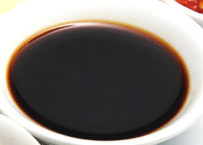 Black Soy Sauce
Black Soy Sauce Fresh red chillies should be slit open and seeds removed before use unless you prefer really hot, in which
case leave seeds and membranes alone. Wear rubber gloves to avoid skin irritation. Hot Chinese chilli sauce
is sold in small bottles and should be kept in the refrigerator after opening. Sweet chilli sauces are often
used as a dipping sauce in most Chinese recipes.
Fresh red chillies should be slit open and seeds removed before use unless you prefer really hot, in which
case leave seeds and membranes alone. Wear rubber gloves to avoid skin irritation. Hot Chinese chilli sauce
is sold in small bottles and should be kept in the refrigerator after opening. Sweet chilli sauces are often
used as a dipping sauce in most Chinese recipes.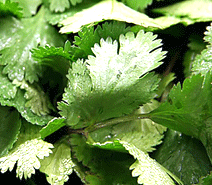 This leafy fronds of the seed spice coriander is more commonly known as Chinese Parsley and coriander.
Pungent, lemony taste, used in most Chinese cooking as part of a dish or garnish.
This leafy fronds of the seed spice coriander is more commonly known as Chinese Parsley and coriander.
Pungent, lemony taste, used in most Chinese cooking as part of a dish or garnish. Dried Shrimps
Dried Shrimps Also known as aubergine. Depending on their age, they may have to be sliced and salted to reduce
their bitterness. Rinse and dry well before using. Baby eggplant (Japanese eggplant) are small
and slender and don't need to be salted before use. Thai egpplant is known as pea eggplant and are green
and white, marbled-sized.
Also known as aubergine. Depending on their age, they may have to be sliced and salted to reduce
their bitterness. Rinse and dry well before using. Baby eggplant (Japanese eggplant) are small
and slender and don't need to be salted before use. Thai egpplant is known as pea eggplant and are green
and white, marbled-sized.
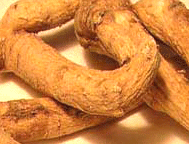 Panax Ginseng, a herb root believed to have certain medicinal properties. Botanical cousin is the American Ginseng, most widely availabe in the USA and America.
Panax Ginseng, a herb root believed to have certain medicinal properties. Botanical cousin is the American Ginseng, most widely availabe in the USA and America.  Fresh root ginger should be skinned (with a spoon) and very thinly sliced, chopped or shredded. Dried ginger is
not a good subsitute but crystallised ginger can be used in emergencies.
Fresh root ginger should be skinned (with a spoon) and very thinly sliced, chopped or shredded. Dried ginger is
not a good subsitute but crystallised ginger can be used in emergencies. Wheat gluten (seitan, wheat meat, gluten meat) is made from the gluten of wheat. It is a great alternative
to soy-bean meat otherwise known as tofu. Deep fried gluten can be purchased in packages.
Other forms of gluten such as steamed gluten (zheng miÓn jin) can be purchased in can forms and baked
spongy gluten (Kao fu) is available in fresh, frozen, and canned forms.
Wheat gluten (seitan, wheat meat, gluten meat) is made from the gluten of wheat. It is a great alternative
to soy-bean meat otherwise known as tofu. Deep fried gluten can be purchased in packages.
Other forms of gluten such as steamed gluten (zheng miÓn jin) can be purchased in can forms and baked
spongy gluten (Kao fu) is available in fresh, frozen, and canned forms. Brewed from wheat, salt and soy beans, is available in several forms. The most common is regular
light soy sauce,a clear medium brown liquid with a salty taste, often used as a table condiment.
Brewed from wheat, salt and soy beans, is available in several forms. The most common is regular
light soy sauce,a clear medium brown liquid with a salty taste, often used as a table condiment.  Also known as jujubes are olive-shaped, dark red fruit of a small thorny evergreen tree.
Red dates have a slightly astringent, prune-like flavor and are available dried at Asian food stores.
Is commonly used to flavor soups and dishes.
Also known as jujubes are olive-shaped, dark red fruit of a small thorny evergreen tree.
Red dates have a slightly astringent, prune-like flavor and are available dried at Asian food stores.
Is commonly used to flavor soups and dishes.
 Mushrooms
Mushrooms Used in Asian cooking as a tenderizer and flavoring. A good alternative to rice wine is dry sherry or sake.
Known as Mijiu or Lao-zao in China and for the rest variety it is known as Ang Jiu which
is quite popular among the FooChow Chinese.
Used in Asian cooking as a tenderizer and flavoring. A good alternative to rice wine is dry sherry or sake.
Known as Mijiu or Lao-zao in China and for the rest variety it is known as Ang Jiu which
is quite popular among the FooChow Chinese.
 Or golden needles are the unopened buds of a variety of Chinese day lily and are prized for their earthly flavor. Buds are available dried at Asian food shops, and are soaked and their tough stems removed before use.
Or golden needles are the unopened buds of a variety of Chinese day lily and are prized for their earthly flavor. Buds are available dried at Asian food shops, and are soaked and their tough stems removed before use.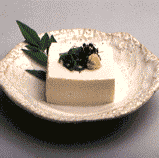 Tofu or Beancurd
Tofu or Beancurd Usually sold in Chinese food stores, it is a dark and mild-tasting vinegar. Not to be confused with the normal
white vinegar. You may subsitute with malt vinegar, rice vinegar or rice vinegar diluted with a bit of water.
Usually sold in Chinese food stores, it is a dark and mild-tasting vinegar. Not to be confused with the normal
white vinegar. You may subsitute with malt vinegar, rice vinegar or rice vinegar diluted with a bit of water. These small rounded crisp vegetables are sold in cans and can sometimes be bought fresh. They have a beautiful
crunchy texture and a bland, very slight sweet taste. Store unused water chestnuts in water in a container
in refrigerator for several days only.
These small rounded crisp vegetables are sold in cans and can sometimes be bought fresh. They have a beautiful
crunchy texture and a bland, very slight sweet taste. Store unused water chestnuts in water in a container
in refrigerator for several days only.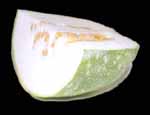 Winter Melon
Winter Melon Known also as wantan, wanton, or wuntun.
Small thin squares of pasta dough, usually made from egg yolks and flour.
The fillings for won ton are usually made from minced pork, shrimp and various minced vegetables.
Sold in stacks of about 30, they can be stored in refrigerator for several days.
Known also as wantan, wanton, or wuntun.
Small thin squares of pasta dough, usually made from egg yolks and flour.
The fillings for won ton are usually made from minced pork, shrimp and various minced vegetables.
Sold in stacks of about 30, they can be stored in refrigerator for several days.